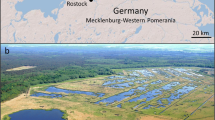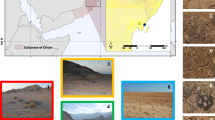Abstract
Biological soil crusts (BSCs) are known as “ecosystem-engineers” that have important, multifunctional ecological roles in primary production, in nutrient and hydrological cycles, and in stabilization of soils. These communities, however, are almost unstudied in coastal dunes of the temperate zone. Hence, for the first time, the biodiversity of cyanobacterial and algal dominated BSCs collected in five dunes from the southern Baltic Sea coast on the islands Rügen and Usedom (Germany) was investigated in connection with physicochemical soil parameters. The species composition of cyanobacteria and algae was identified with direct determination of crust subsamples, cultural methods, and diatom slides. To investigate the influence of soil properties on species composition, the texture, pH, electrical conductivity, carbonate content, total contents of carbon, nitrogen, phosphorus, and the bioavailable phosphorus-fraction (PO4 3−) were analyzed in adjacent BSC-free surface soils at each study site. The data indicate that BSCs in coastal dunes of the southern Baltic Sea represent an ecologically important vegetation form with a surprisingly high site-specific diversity of 19 cyanobacteria, 51 non-diatom algae, and 55 diatoms. All dominant species of the genera Coleofasciculus, Lyngbya, Microcoleus, Nostoc, Hydrocoryne, Leptolyngbya, Klebsormidium, and Lobochlamys are typical aero-terrestrial cyanobacteria and algae, respectively. This first study of coastal sand dunes in the Baltic region provides compelling evidence that here the BSCs were dominated by cyanobacteria, algae, or a mixture of both. Among the physicochemical soil properties, the total phosphorus content of the BSC-free sand was the only factor that significantly influenced the cyanobacterial and algal community structure of BSCs in coastal dunes.





Similar content being viewed by others
References
Martínez ML, Psuty NP, Lubke RA (2004) A perspective on coastal dunes. In: Martínez ML, Psuty NP (eds) Coastal dunes: ecology and conservation. Springer-Verlag, pp 3–10
Miller TE, Gornish ES, Buckley HL (2009) Climate and coastal dune vegetation: disturbance, recovery, and succession. Plant Ecol 206:97–104. doi:10.1007/s11258-009-9626-z
Virginia Marine Resources Commission (1989) Coastal primary sand dunes/beaches guidelines. Guidelines for the permitting of activities which encroach into coastal primary sand dunes/beaches. Reprinted 1993
García Novo F, DíazBarradas MC, Zunzunegui M, GarcíaMora R, GallegoFernández JB (2004) Plant functional types in coastal dune habitats. In: Martínez ML, Psuty NP (eds) Coastal dunes: ecology and conservation. Springer-Verlag, pp 155–169
Belnap J, Büdel B, Lange OL (2001) Biological soil crusts: characteristics and distribution. In: Belnap J, Lange OL (eds) Biological soil crusts: structure, function, and management. Springer-Verlag, pp 3–30
Breen K, Lévesque E (2008) The influence of biological soil crusts on soil characteristics along a high arctic glacier foreland, Nunavut, Canada. Arct Antarct Alp Res 40:287–297. doi:10.1657/1523-0430(06-098)[BREEN]2.0.CO;2
Fischer T, Veste M, Bens O, Hüttl RF (2012) Dew formation on the surface of biological soil crusts in central European sand ecosystems. Biogeosciences 9:4621–2628. doi:10.5194/bg-9-4621-2012
Colesie C, Gommeaux M, Green ATG, Büdel B (2013) Biological soil crusts in continental Antarctica: Garwood Valley, southern Victoria Land, and Diamond Hill, Darwin Mountains region. Antarct Sci 26:115–123. doi:10.1017/S0954102013000291
Van den Acker JAM, Jungerius PD (1985) The role of algae in the stabilization of coastal dune blowouts. Earth Surf Proc Land 10:189–192. doi:10.1002/esp.3290100210
Grote EE, Belnap J, Housman DC, Sparks JP (2010) Carbon exchange in biological soil crusts communities under differential temperatures and soil water contents: implications for global change. Glob Chang Biol 16:2763–2774. doi:10.1111/j.1365-2486.2010.02201.x
Belnap J (2002) Nitrogen fixation in biological soil crusts from southeast Utah, USA. Biol Fertil Soils 35:128–135. doi:10.1007/s00374-002-0452-x
Wu Y, Rao B, Wu P, Liu Y, Li G, Li D (2013) Development of artificially induced biological soil crusts in fields and their effects on top soil. Plant Soil 370:115–124. doi:10.1007/s11104-013-1611-6
Belnap J (2006) The potential roles of biological soil crusts in dryland hydrologic cycles. Hydrol Process 20:3159–3178. doi:10.1002/hyp.6325
Harper KT, Belnap J (2001) The influence of biological soil crusts on mineral uptake by associated vascular plants. J Arid Environ 47:347–357. doi:10.1006/jare.2000.0713
Büdel B (2001) Synopsis: comparative biogeography and ecology of soil-crust biota. In: Belnap J, Lange OL (eds) Biological soil crusts: structure, function, and management. Springer-Verlag, pp 141–152
Ashley J, Rushforth SR, Johansen JR (1985) Soil algae of cryptogamic crusts from the Uintah Basin, Utah, U.S.A. Great Basin Nat 45:432–442
Flechtner VR, Johansen JR, Clark WH (1998) Algal composition of microbiotic crusts from the central desert of Baja California, Mexico. Great Basin Nat 58:295–311
Hoppert M, Reimer R, Kemmling A, Schröder A, Günzl B, Heinken T (2004) Structure and reactivity of a biological soil crust from a xeric sandy soil in Central Europe. Geomicrobiol J 21:183–191. doi:10.1080/01490450490275433
Lukešová A, Hoffmann L (1996) Soil algae from acid rain impacted forest areas of the Krušné Hory Mts. 1. Algal communities. Vegetatio 125:123–136. doi:10.1007/BF00044646
Tomas AD, Dougill AJ (2006) Distribution and characteristics of cyanobacterial soil crusts in the Molopo Basin, South Africa. J Arid Environ 64:270–283. doi:10.1016/j.jaridenv.2005.04.011
Büdel B, Darienko T, Deutschewitz K, Dojani S, Friedl T, Mohr KI, Salisch M, Reisser W, Weber B (2009) Southern African biological soil crusts are ubiquitous and highly diverse in drylands, being restricted by rainfall frequency. Microb Ecol 57:229–247. doi:10.1007/s00248-008-9449-9
Büdel B, Colesie C, Green TGA, Grube M, Lázaro Suau R, Loewen-Schneider K, Maier S, Peer T, Pintado A, Raggio J, Ruprecht U, Sancho LG, Schroeter B, Türk R, Weber B, Wedin M, Westberg M, Williams L, Zheng L (2014) Improved appreciation of the functioning and importance of biological soil crusts in Europe: the Soil Crust International Project (SCIN). Biodivers Conserv 23:1639–1658. doi:10.1007/s10531-014-0645-2
De Winder B (1990) Ecophysiological strategies of drought-tolerant phototrophic microorganisms in dune soils. Dissertation, University of Amsterdam
Pluis JLA, de Winder B (1990) Natural stabilization. Catena Suppl 18:195–208
Smith SM, Abed RMM, Garcia-Pichel F (2004) Biological soil crusts of sand dunes in Cape Cod National Seashore, Massachusetts, USA. Microb Ecol 48:200–208. doi:10.1007/s00248-004-0254-9
Müller-Westermeier G, Kreis A, Dittmann E, Barfus K, Czeplak G, Riecke W (2003) Klimaatlas Bundesrepublik Deutschland Teil 3 Bewölkung, Globalstrahlung, Anzahl der Tage klimatologischer Ereignisse, Phänologie. (DeutscherWetterdienst)
Bischoff HW, Bold HC (1963) Some soil algae from Enchanted Rock and related algal species. Phycol Stud IV Univ Texas Publ 6318:1–95
Starr RC, Zeikus JA (1993) UTEX – the culture collection of algae at the University of Texas at Austin 1993 list of cultures. J Phycol 29:1–106. doi:10.1111/j.0022-3646.1993.00001.x
Ettl H, Gärtner G (2014) Syllabus der Boden-, Luft- und Flechtenalgen, 2nd edn. Springer, Berlin
Komárek J, Anagnostidis K (1998) Cyanoprokaryota 1 Teil: Chroococcales. Süsswasserflora von Mitteleuropa, Bd 19/1. Spektrum, Akad. Verl., Heidelberg, Berlin
Komárek J, Anagnostidis K (2005) Cyanoprokaryota 2 Teil: Oscillatoriales. Süsswasserflora von Mitteleuropa, Bd 19/2. Spektrum, Akad. Verl., München
Komárek J (2013) Cyanoprokaryota. Heterocytous genera, Süsswasserflora von Mitteleuropa, Bd. 19/3. Springer Spektrum
Krammer K, Lange-Bertalot H (1991a) Bacillariophyceae 3. Teil: Centrales, Fragilariaceae, Eunotiaceae. In: Süsswasserflora von Mitteleuropa. Band 2/3. Gustav Fischer Verlag
Krammer K, Lange-Bertalot H (1991b) Bacillariophyceae 4. Teil: Achnanthaceae. In: Süsswasserflora von Mitteleuropa. Band 2/4. Gustav Fischer Verlag
Krammer K (2000) The genus Pinnularia. In: Diatoms of Europe Vol. 1. A.R.G. Gantner Verlag K.G
Witkowski A, Lange-Bertalot H, Metzeltin D (2000) Diatom flora of marine coasts vol. 1, Iconographia Diatomologica. A.R.G. Gantner Verlag
Lange-Bertalot H (2001) Navicula sensu stricto.10 genera separated from Navicula sensu lato. Frustulia. In Diatoms of Europe Vol. 2. A.R.G. Gantner Verlag K.G
Lange-Bertalot H, Cavacini P, Tagliaventi N, Alfinito S (2003) Diatoms of Sardinia. Rare and 76 new species in rock pools and other ephemeral waters. Iconographia Diatomologica. In Annotated diatom monographs vol. 12: biogeography - ecology – taxonomy. A.R.G. Gantner Verlag
Hofmann G, Werum M, Lange-Bertalot H (2013) Diatomeen im Süßwasser-Benthos von Mitteleuropa. Bestimmungsflora Kieselalgen für die ökologische Praxis. Über 700 der häufigsten Arten und ihre Ökologie. Koeltz Scientific Books
Blume H-P, Stahr K, Leinweber P (2011) Bodenkundliches Praktikum, 3rd edn. Spektrum Akademischer Verlag, Heidelberg
Ad hoc- Arbeitsgruppe Boden (2005) Bodenkundliche Kartieranleitung. 5. Aufl. Hannover
Johansen JR, Ashley J, Rayburn WR (1993) Effects of rangefire on soil algal crusts in semiarid shrub-steppe of the lower Columbia Basin and their subsequent recovery. Great Basin Nat 53:73–88
Cabała J, Rhamonov O (2004) Cyanophyta and algae as an important component of biological crust from the Pustynia Błędowska Desert (Poland). Polish Bot J 49:93–100
Lukešová A (2001) Soil algae in brown coal and lignite post-mining areas in Central Europe (Czech Republic and Germany). Restor Ecol 9:341–350. doi:10.1046/j.1526-100X.2001.94002.x
Langhans TM, Storm C, Schwabe A (2009) Community assembly of biological soil crusts of different successional stages in a temperate sand ecosystem, as assessed by direct determination and enrichment techniques. Microb Ecol 58:394–407. doi:10.1007/s00248-009-9532-x
Hawkes CV, Flechtner VR (2002) Biological soil crusts in a xeric Florida shrubland: composition, abundance, and spatial heterogeneity of crusts with different disturbance histories. Microb Ecol 43:1–12. doi:10.1007/s00248-001-1017-5
Garcia-Pichel F, López-Cortés A, Nübel U (2001) Phylogenetic and morphological diversity of cyanobacteria in soil desert crusts from the Colorado Plateau. Appl Environ Microbiol 67:1902–1910. doi:10.1128/AEM.67.4.1902-1910.2001
Cardon ZG, Gray DW, Lewis LA (2008) The green algal underground: evolutionary secrets of desert cells. Bioscience 58:114–122. doi:10.1641/B580206
Johansen JR (1993) Cryptogamic crusts of semiarid and arid lands of North America. J Phycol 29:140–147. doi:10.1111/j.0022-3646.1993.00140.x
Kaštovská K, Elster J, Stibal M, Šantrůčková H (2005) Microbial assemblages in soil microbial succession after glacial retreat in Svalbard (High Arctic). Microb Ecol 50:396–407. doi:10.1007/s00248-005-0246-4
Johansen JR, Rushforth SR, Brotherson JD (1981) Subaerial algae of Navajo National Monument, Arizona. Great Basin Nat 41:433–439
Darby DA, Burckle LH, Clark DL (1974) Airborne dust on the Arctic ice pack, its composition and fallout rate. Earth Planet Sci Lett 24:166–172. doi:10.1016/0012-821X(74)90093-4
Lee TF, Eggleston PM (1989) Airborne algae and cyanobacteria. Grana 28:63–66. doi:10.1080/00173138909431014
Walker TW, Syers JK (1976) The fate of phosphorus during pedogenesis. Geoderma 15:1–19
Schmidt SK, Nemergut DR, Todd BT, Lynch RC, Darcy JL, Cleveland CC, King AJ (2012) A simple method for determining limiting nutrients for photosynthetic crusts. Plant Ecol Divers 5:513–519. doi:10.1080/17550874.2012.738714
Anderson DC, Harper KT, Holmgren RC (1982) Factors influencing development of cryptogamic soil crusts in Utah deserts. J Range Manag 35:180–185. doi:10.2307/3898386
Levin N, Kidron GJ, Ben-Dor E (2007) Surface properties of stabilizing coastal dunes: combining spectral and field analyses. Sedimentology 54:771–788. doi:10.1111/j.1365-3091.2007.00859.x
Acknowledgments
We thank Elena Heilmann, Dr. Dana Zimmer, and Britta Balz (Soil Science, University of Rostock, Germany) for their technical support during soil analyses as well as Dr. Anastasia Kryvenda and Natalya Rybalka (University of Göttingen, Germany) for help in identification of some Xanthophyceae. The work has been partly funded by the Deutsche Forschungsgemeinschaft (DFG) Priority Program 1374 “Infrastructure-Biodiversity-Exploratories” (Project Crustfunction KA899/28-1) and the Leibniz Science Campus Phosphorus Research Rostock. T.M. thanks the Alexander von Humboldt Foundation for financial support (Georg-Forster research fellowship at the University of Rostock).
Author information
Authors and Affiliations
Corresponding author
Ethics declarations
Conflict of Interest
The authors declare that they have no conflict of interest.
Ethical Approval
This article does not contain any studies with human participants or animals performed by any of the authors.
Electronic supplementary material
Below is the link to the electronic supplementary material.
ESM 1
(PDF 7 kb)
Rights and permissions
About this article
Cite this article
Schulz, K., Mikhailyuk, T., Dreßler, M. et al. Biological Soil Crusts from Coastal Dunes at the Baltic Sea: Cyanobacterial and Algal Biodiversity and Related Soil Properties. Microb Ecol 71, 178–193 (2016). https://doi.org/10.1007/s00248-015-0691-7
Received:
Accepted:
Published:
Issue Date:
DOI: https://doi.org/10.1007/s00248-015-0691-7




